Samsung Galaxy S III Review - AT&T and T-Mobile USA Variants
by Brian Klug on June 20, 2012 12:01 AM ESTWe’ve already seen dual core Krait (MSM8960) performance before and talked about it in the HTC One X (AT&T) review. For the most part, what we see with the USA SGS3 variants is largely the same as what we saw in MSM8960 (or MSM8260A, the same part with different baseband).
If you’re looking for a comparison to the International SGS3 with Exynos 4412, my unit hasn’t quite arrived yet. Anand and I plan to take a comprehensive look at the SoC performance landscape (Tegra 3 / MSM8960 / Exynos 4412) in another review after we’ve had time with the international SGS3. I have benchmark numbers from our SGS3 international preview at the launch event, but those were from pre-final software.
Where the SGS3 differentiates itself from what’s becoming a slew of USA-bound devices with MSM8960 is available RAM. In this case, all of the USA SGS3s include 2 GB of LPDDR2 RAM, of which 1.62 GB is available to user applications. My own suspicions for why this is the case is that Samsung wanted to make sure they had at least 1 GB available for user space applications. Clearly there is 380 MB absorbed for both preallocated GPU memory, and possibly DRM / baseband, and after that subtraction the only way to get dual channel (2x32b) LPDDR2 is to make the jump to two 1 GB LPDDR2 devices.
That’s my own speculation, but either way with the SGS3 you get ample RAM for applications. The positive thing is that even if you launch a ton of applications, it’s unlikely they’ll get tombstoned. I fired up my regular set of daily driver applications (twitter, baconreader, chrome, messaging, speedtest, radarscope, and a few others) and managed to use up nearly 1 GB.
JavaScript Performance
Although smartphones are clearly headed for a life beyond as a communications tool, web browsing, or phone duties, we are still lacking the tools to measure performance in areas other than a component of web page performance. Measuring JavaScript performance is one component of the entire web page rendering process but it’s the most mature in terms of something we can benchmark.
Sunspider 0.9.1 is quite possibly the most well known of these JavaScript tests, and a regular staple of our testing suite:
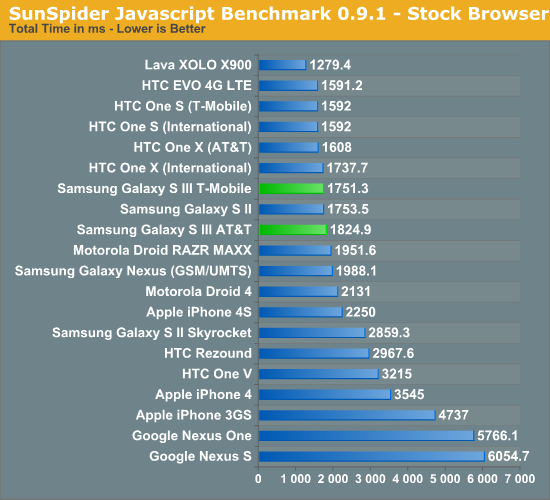
Like the other 1.5 GHz MSM8960 devices, the SGS3 does pretty well, but still is around 150ms slower. I ran this test multiple times but consistently got results in the 1750s or low 1800s for the SGS3s.
Browsermark is the next JavaScript test in our suite, and here it does very favorably against the rest of the competition.
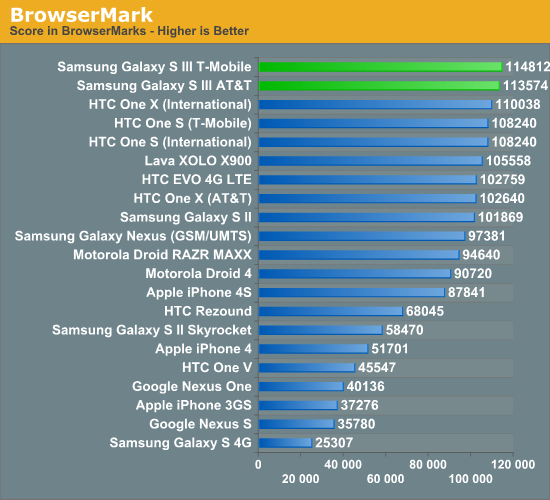
It’s interesting to see the SGS3 not do stellar in Sunspider, but excellent in Browsermark. Note that in our preview piece, I did see the International SGS3 post a score of 161k here.
Next up is Vellamo, which is a Qualcomm benchmark developed originally for OEMs to use and optimize their browser performance, and later released for general use. It’s a regular member of our test suite and includes both JavaScript tests and scrolling tests that stress the display composition and hardware acceleration in the browser.
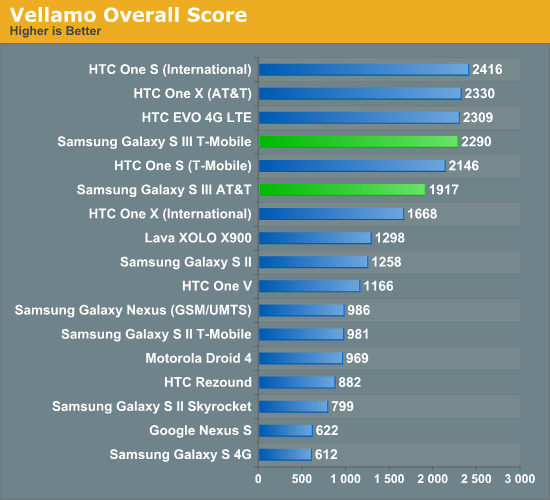
I saw an interesting deviation here between the AT&T and T-Mobile version, for reasons I cannot explain despite multiple reboots and making sure everything was closed. Either way, the devices both have stock browsers that feel like butter, absolutely smooth when translating or zooming around.
Low Level FP Performance
Linpack isn’t a great indication of overall smartphone performance, but it is a good test of the floating point capabilities of the CPUs in these SoCs. ARM has steadily been improving FP performance for the past few generations but we’re going to see a big jump to Krait/A15. As most client smartphone workloads are integer based and those that are FP heavy end up relying on the GPU, an advantage here doesn’t tell us much today (particularly because Linpack isn’t running native code but rather atop Dalvik) other than how speedy the FPUs are. There’s a new port of Linpack which runs using native code which we’ll be trying out in the big performance comparison piece.
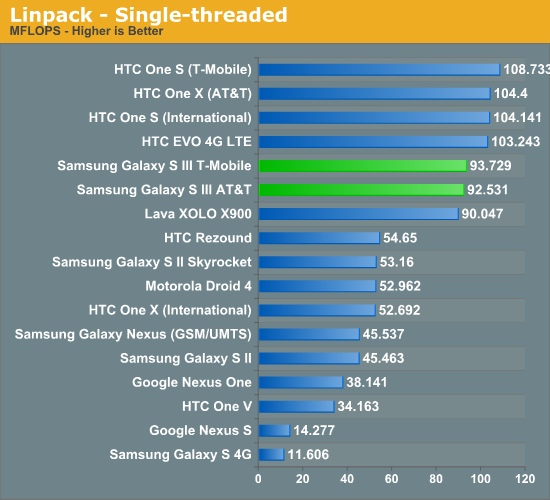
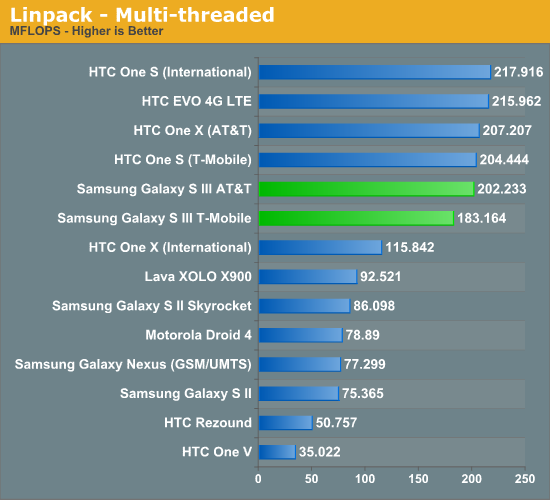
As we’ve shown before, FP performance on Krait is superb thanks to its architectural advantages over a straight A9. I find that FP performance was more relevant of a benchmark when display rendering was being done in CPU instead of on the GPU with the new OpenGL ES 2.0 render paths. Still, it’s worth talking about.
BaseMark OS
Rightware’s BaseMark OS is a general purpose benchmark designed to better simulate overall Android performance. It includes a heavily threaded benchmark, file IO tests, and compression/decompression tasks that all contribute to its overall score.
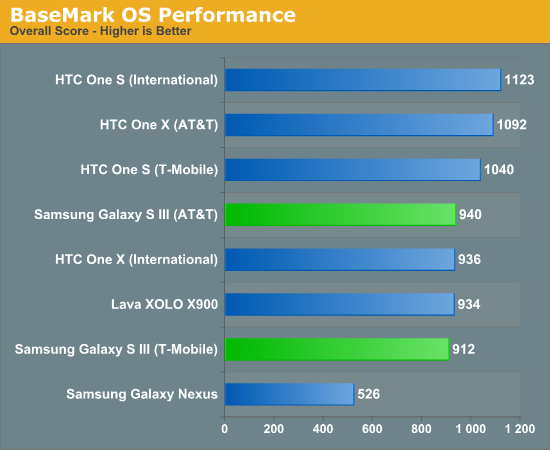
Basemark OS is relatively new to us but we’re adding more and more phones as time goes on for comparison purposes. Curiously enough the SGS3s post numbers a bit shy of their HTC cousins. I think that in spite of this, you’d be hard pressed to tell the Krait based One X and Krait based SGS3 apart.
GPU Performance - GLBenchmark 2.1
As we wait for actual 3D gaming benchmarks to make their way into Android (and hopefully crossplatform) games, we must rely on synthetic tests designed to simulate 3D game performance as best as possible. We start with GLBenchmark, one of the better Android GPU tests on the market today. There are two benchmarks, Egypt and Pro, and each is run in two modes: native screen resolution and offscreen (vsync disabled) at 720p. The latter is more useful for apples to apples comparisons as everything is rendering the same number of pixels, whereas performance in the onscreen tests is determined by the screen resolution of the device along with the performance of its GPU.
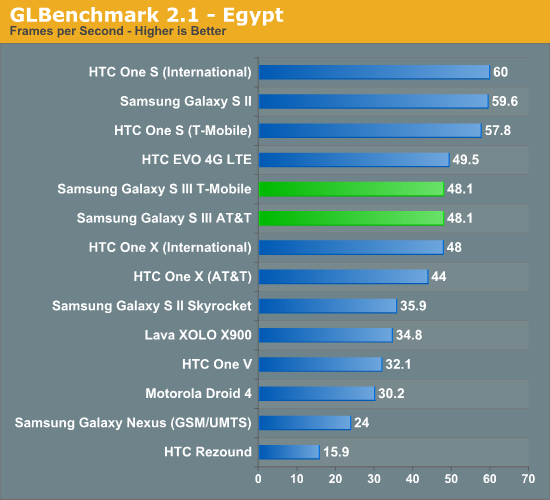
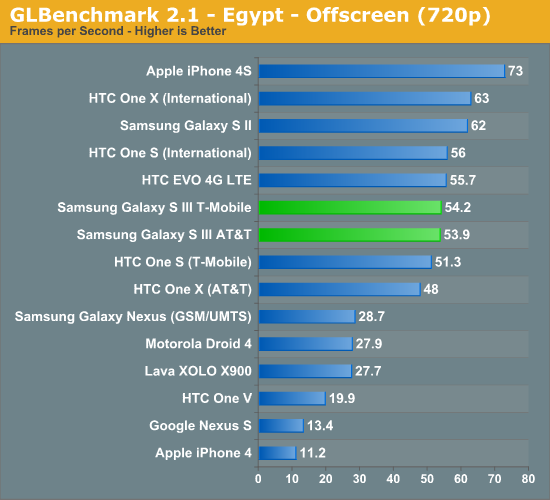
As a reminder, only the Egypt offscreen test takes place with vsync turned off, which is why you see devices with 720p displays posting different results on versus off screen where vsync is off. Part of the deal in getting Krait to market as quickly as possible required that Qualcomm pair the CPU with an older GPU, in this case the Adreno 225 instead of the newer Adreno 3xx offerings due out later this year in SoCs like MSM8960 Pro or the quad core Krait APQ8064. As a result, you can see the SGS2 with Exynos 4210 pull ahead in both tests. Obviously the on-screen test isn’t a totally fair comparison because of the inherent difference in resolution - 720p vs WVGA.
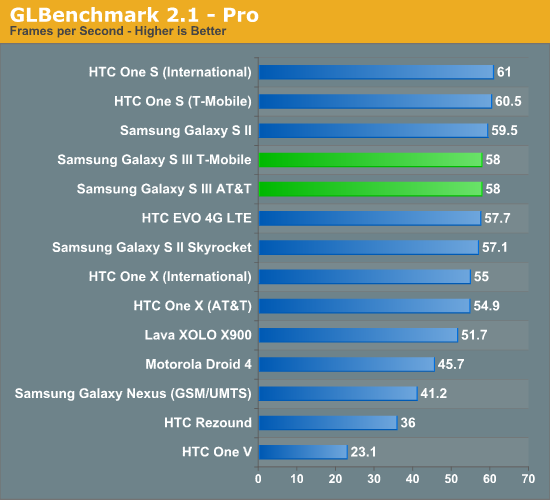
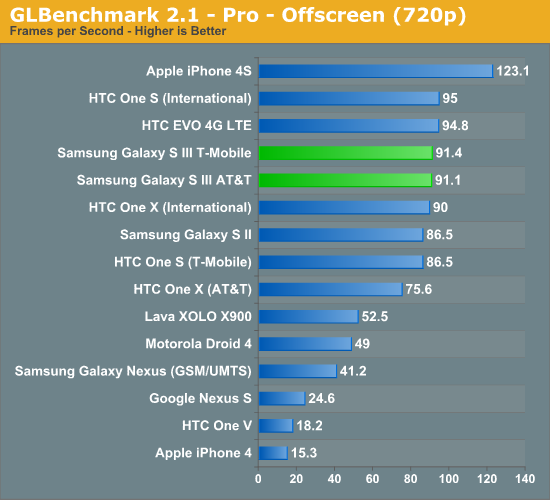
In the older Pro offscreen test, we see Adreno 225 trading spots with SGS2’s Mali–400 and coming out on top.
Basemark ES 2.0 V1
Rightware’s Basemark ES 2.0 V1 is an aging GPU test that tends to favor Qualcomm’s Adreno GPUs above almost all others:
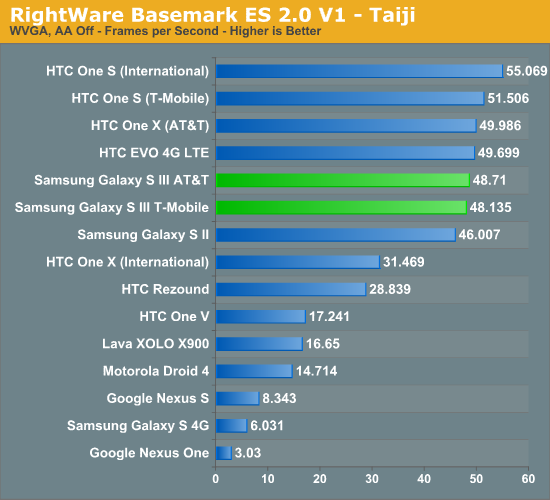
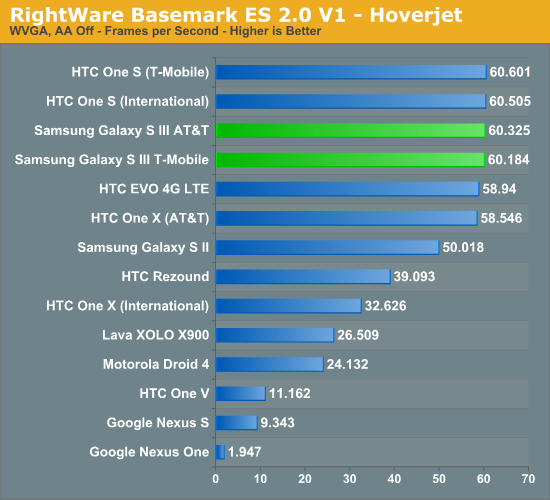
Basemark ES 2.0 is definitely starting to show its age, as Hoverjet is at vsync essentially the whole time, and Taiji is getting there as well. In addition, Qualcomm appears to be using ES 2.0 as an optimization target, so I wouldn’t put too much faith in the ES 2.0 results.


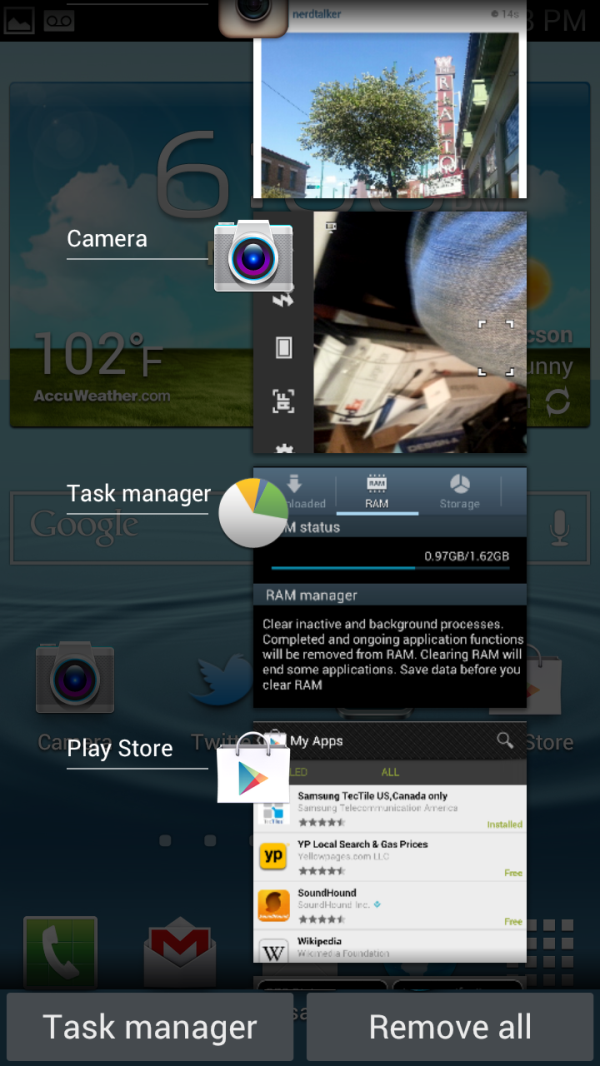
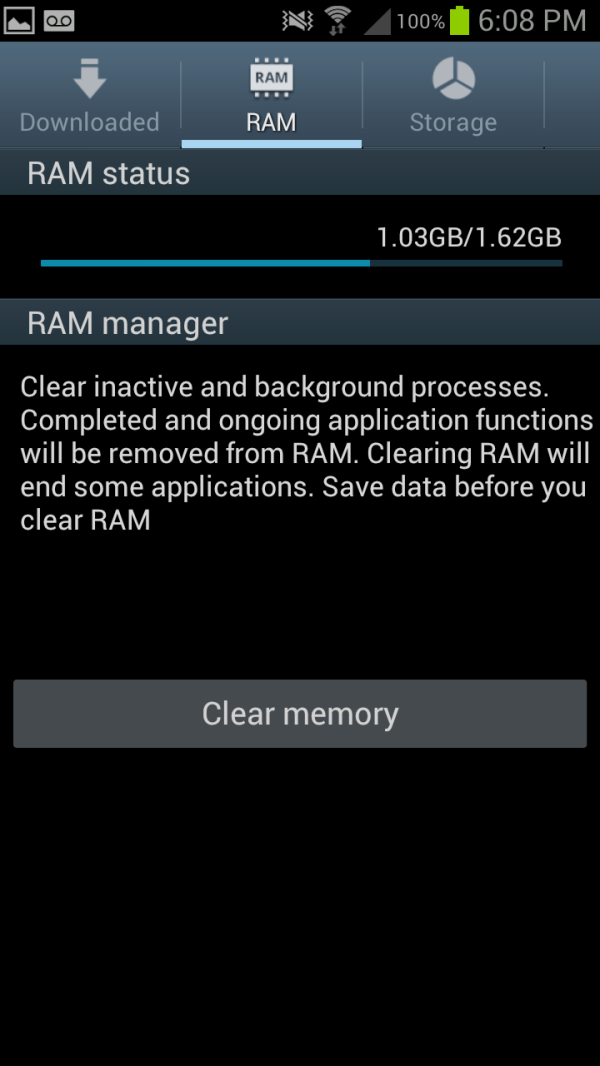








107 Comments
View All Comments
Impulses - Wednesday, June 20, 2012 - link
Did the CDMA variants get skipped because Anand usually reviews those (I think?) And he's been traveling or just luck of the draw? Is the review of the EVO LTE and other One variants still coming? Just curious really, I know sometimes battery life results vary wildly between GSM and CDMA versions of the same basic design, throw LTE in there and still-growing networks and it's something worth looking at.alik - Wednesday, June 20, 2012 - link
Visit http://samsunggalaxysiiicellphone.com/ to get best price and deals for Samsung Galaxy S IIITorrijos - Wednesday, June 20, 2012 - link
In a recent article (HTC One X) you plotted a graph of the battery life (time) divided by the battery capacity (Watt-hours), it would be interesting to get it at each review or at least with reviews marking the arrival of a new version of an OS, in order to check whether their energy efficiency is going in the right direction.falc0ne - Wednesday, June 20, 2012 - link
Packed with all the latest technology but in a soap-bar shape. Galaxy SII looks much better.Someone said here shame doesn't have "pentaband support". You don't need that. What you need is that the phone you purchase to support the band of your operator. That's all. More than that, lately people usually purchase the phone straight from the operator
Zoomer - Sunday, June 24, 2012 - link
That doesn't help if you switch operators often.www.dasinu.ro - Wednesday, June 20, 2012 - link
nice post...http://www.dasinu.rojjj - Wednesday, June 20, 2012 - link
still a very poor selection for battery tests (just web and talk time,what are you testing dumbphones?) ,no storage perf tests,at this point i'm about to give up on hoping you guys can do better.bmgoodman - Wednesday, June 20, 2012 - link
Can you start doing some tests of Bluetooth, both for voice and music? With my Galaxy SII, I've almost quit using my car's integrated hands-free system. Five years in my car using a Sony Ericsson with the handsfree and I almost NEVER had a complaint. Now people are almost always asking me to call back later!BabelHuber - Wednesday, June 20, 2012 - link
I had the same problem regarding Bluetooth. My good old Nokia Symbian phones supported rSAP. Android, iOS and Windows Phone do not.That's why I bought the SGS2, it was the only Android phone supporting rSAP.
In its wisdom, Samsung has removed the rSAP capability with ICS, though.
Fortunately Android is an open system, so I could root it and install an rSAP app.
This was a Sunday afternoon of work, though.
The app is here: http://www.android-rsap.com/installation.html
Angry AtAndroid - Monday, June 25, 2012 - link
Not Samsung removed it, but that big bully google. It is not supported by android.Complaints going on about this for YEARS. See the google code site.
Issue 4402: rSAP / Sim access bluetooth profile
1829 people starred this issue.
http://code.google.com/p/android/issues/detail?can...